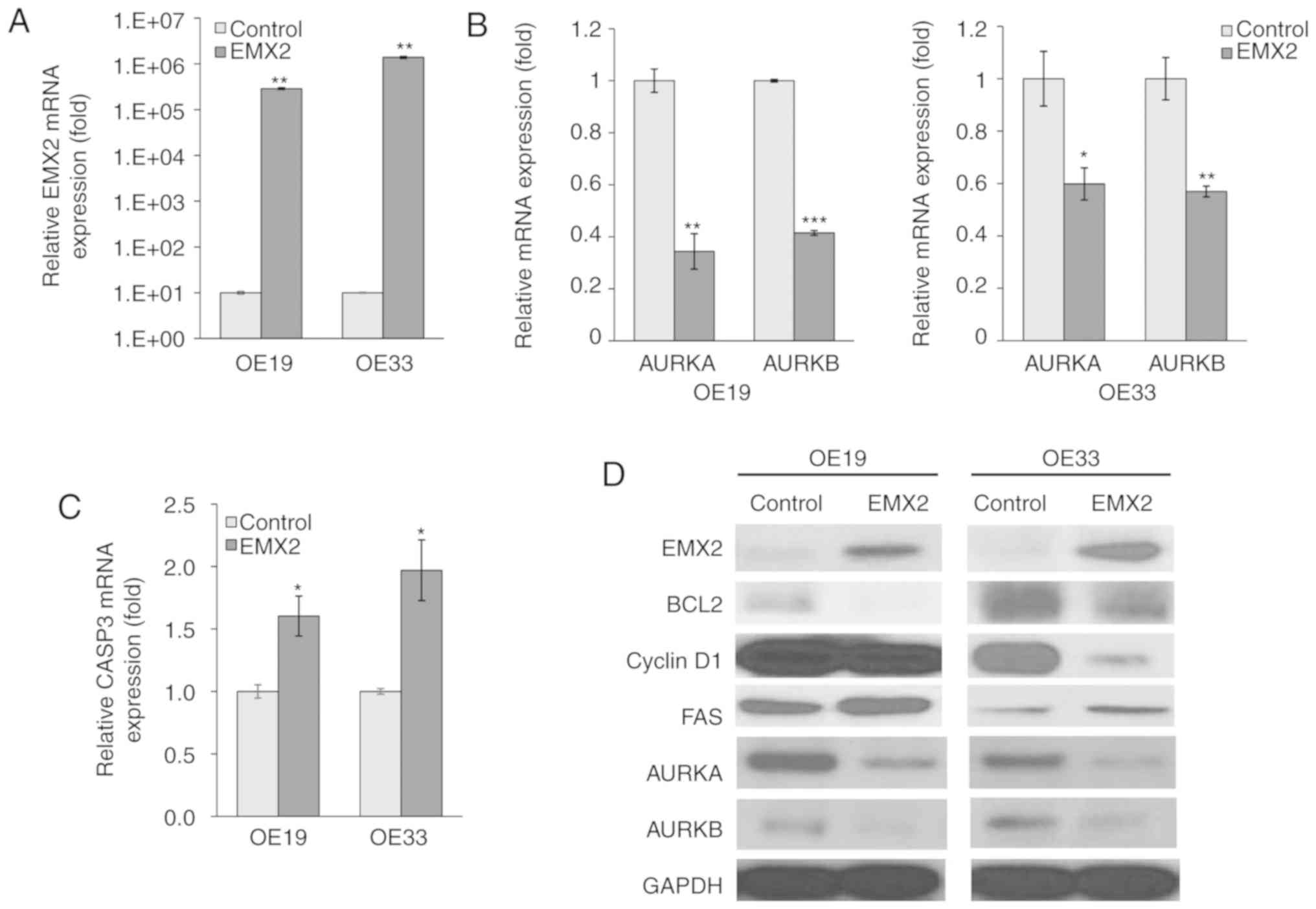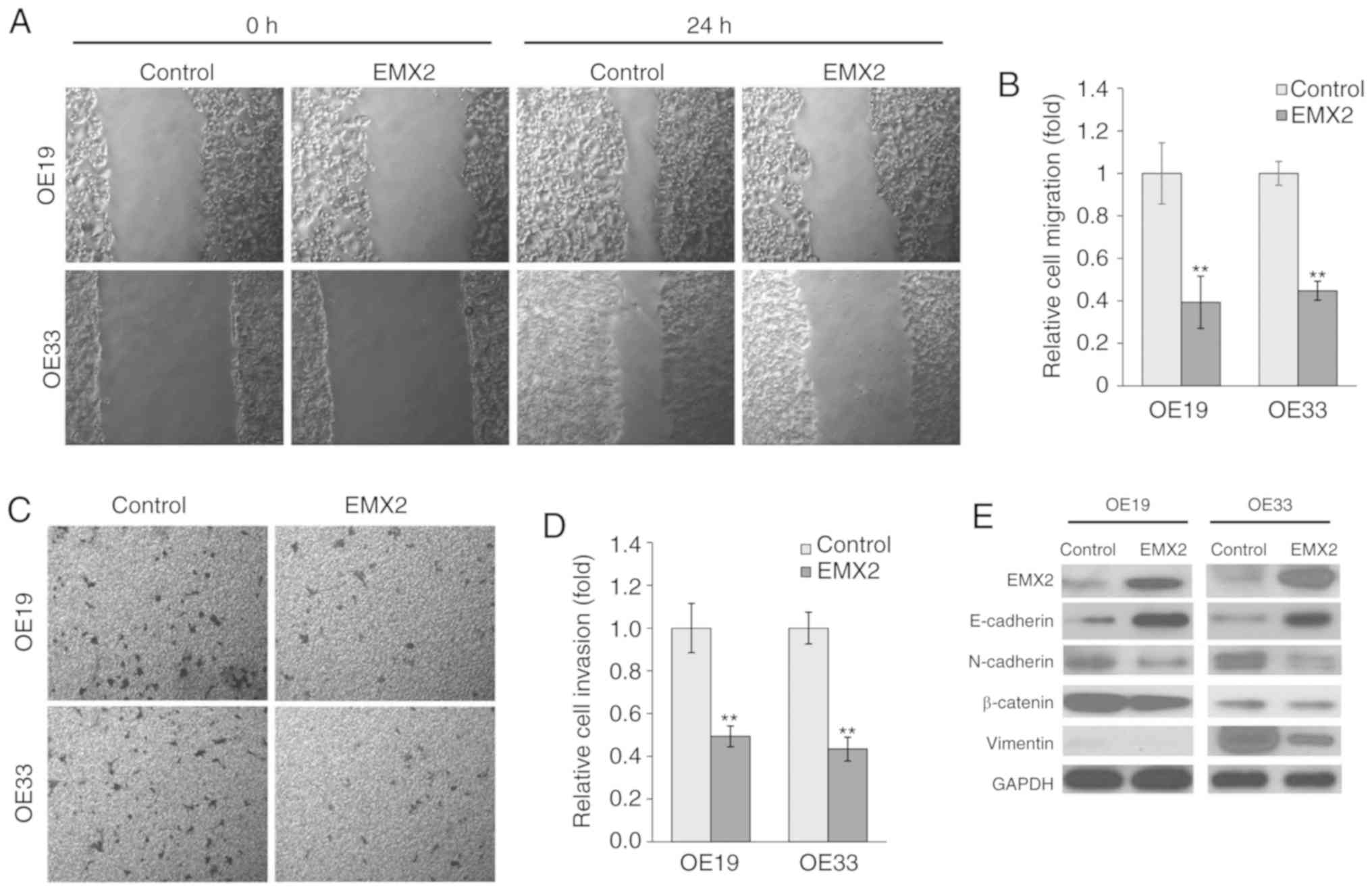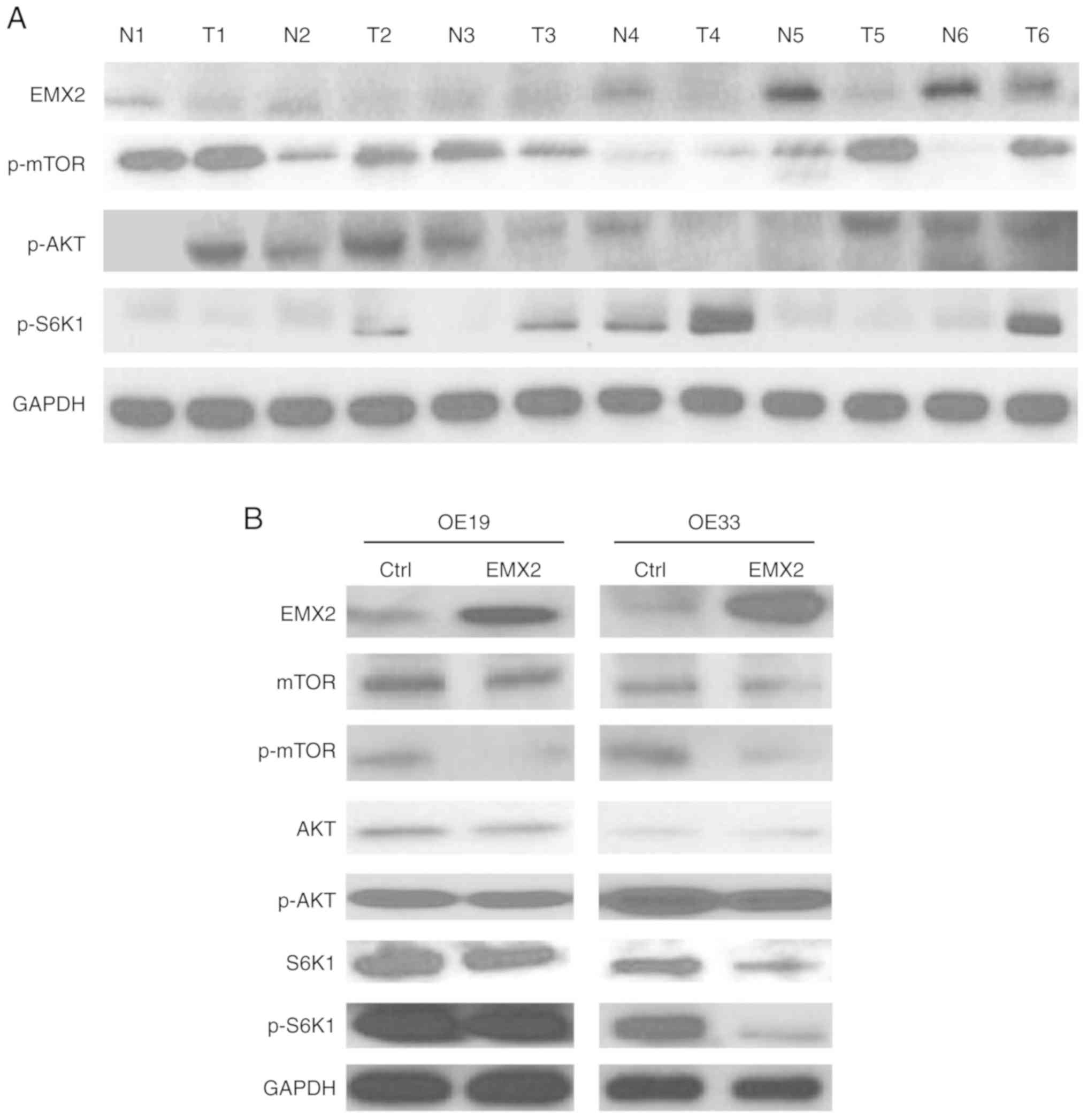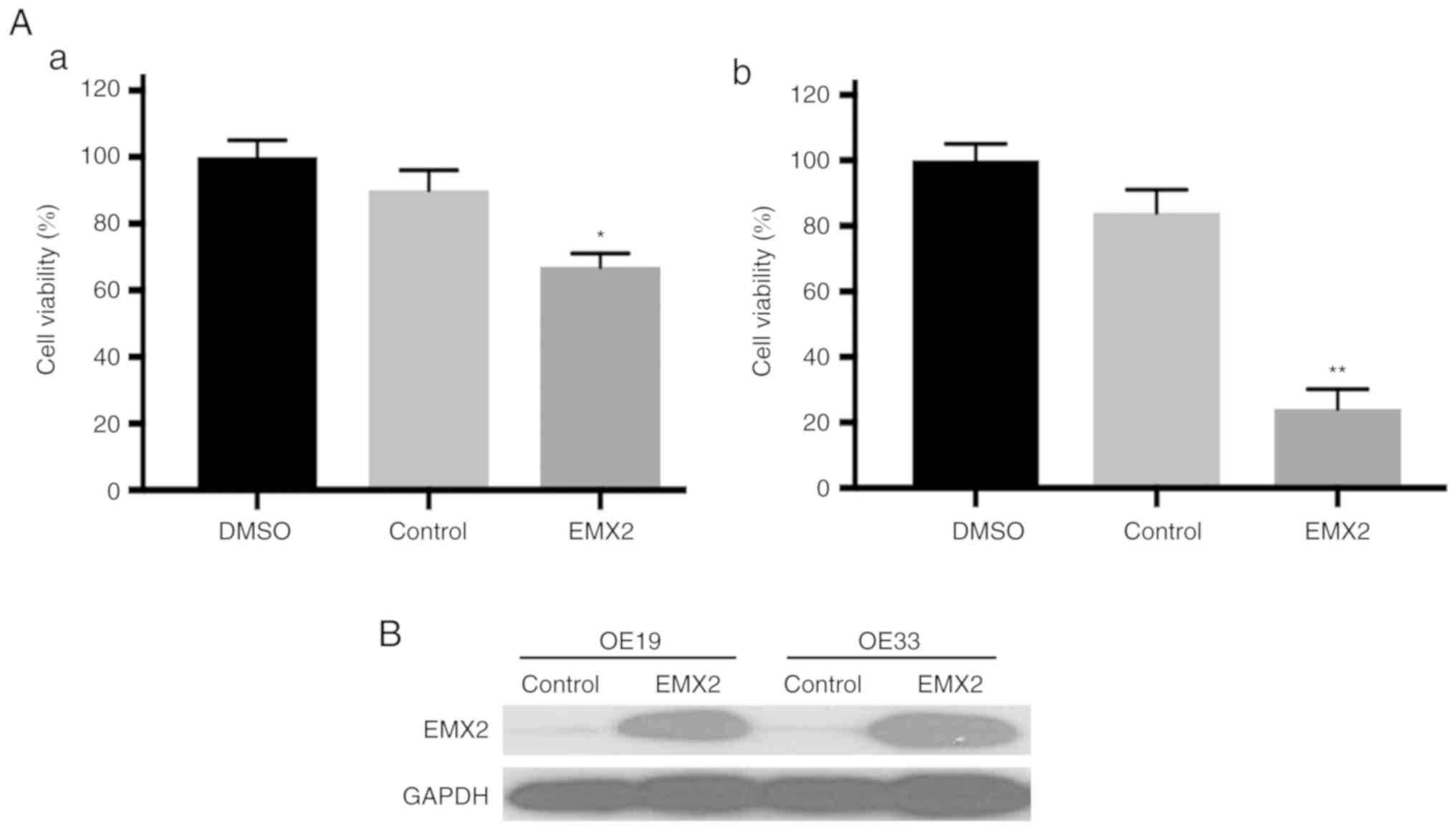|
1
|
Ferlay J, Soerjomataram I, Dikshit R, Eser
S, Mathers C, Rebelo M, Parkin DM, Forman D and Bray F: Cancer
incidence and mortality worldwide: Sources, methods and major
patterns in GLOBOCAN 2012. Int J Cancer. 136:E359–E386. 2015.
View Article : Google Scholar : PubMed/NCBI
|
|
2
|
Cancer Genome Atlas Research Network;
Analysis Working Group: Asan University; BC Cancer Agency; Brigham
and Women's Hospital; Broad Institute; Brown University; Case
Western Reserve University; Dana-Farber Cancer Institute; Duke
University; Greater Poland Cancer Centre, et al, . Integrated
genomic characterization of oesophageal carcinoma. Nature.
541:169–175. 2017. View Article : Google Scholar : PubMed/NCBI
|
|
3
|
Arnold M, Soerjomataram I, Ferlay J and
Forman D: Global incidence of oesophageal cancer by histological
subtype in 2012. Gut. 64:381–387. 2015. View Article : Google Scholar : PubMed/NCBI
|
|
4
|
Siegel RL, Miller KD and Jemal A: Cancer
statistics, 2018. CA Cancer J Clin. 68:7–30. 2018. View Article : Google Scholar : PubMed/NCBI
|
|
5
|
Lagarde SM, ten Kate FJ, Richel DJ,
Offerhaus GJ and van Lanschot JJ: Molecular prognostic factors in
adenocarcinoma of the esophagus and gastroesophageal junction. Ann
Surg Oncol. 14:977–991. 2007. View Article : Google Scholar : PubMed/NCBI
|
|
6
|
Nieto MA, Huang RY, Jackson RA and Thiery
JP: Emt: 2016. Cell. 166:21–45. 2016. View Article : Google Scholar : PubMed/NCBI
|
|
7
|
Polyak K and Weinberg RA: Transitions
between epithelial and mesenchymal states: Acquisition of malignant
and stem cell traits. Nat Rev Cancer. 9:265–273. 2009. View Article : Google Scholar : PubMed/NCBI
|
|
8
|
Thiery JP, Acloque H, Huang RY and Nieto
MA: Epithelial-mesenchymal transitions in development and disease.
Cell. 139:871–890. 2009. View Article : Google Scholar : PubMed/NCBI
|
|
9
|
Tsai JH and Yang J: Epithelial-mesenchymal
plasticity in carcinoma metastasis. Genes Dev. 27:2192–2206. 2013.
View Article : Google Scholar : PubMed/NCBI
|
|
10
|
Rees JR, Onwuegbusi BA, Save VE, Alderson
D and Fitzgerald RC: In vivo and in vitro evidence for transforming
growth factor-beta1-mediated epithelial to mesenchymal transition
in esophageal adenocarcinoma. Cancer Res. 66:9583–9590. 2006.
View Article : Google Scholar : PubMed/NCBI
|
|
11
|
Kestens C, Siersema PD, Offerhaus GJ and
van Baal JW: BMP4 signaling is able to induce an
epithelial-mesenchymal transition-like phenotype in Barrett's
esophagus and esophageal adenocarcinoma through induction of
SNAIL2. PLoS One. 11:e01557542016. View Article : Google Scholar : PubMed/NCBI
|
|
12
|
Wang L, Jin JQ, Zhou Y, Tian Z, Jablons DM
and He B: Gli is activated and promotes epithelial-mesenchymal
transition in human esophageal adenocarcinoma. Oncotarget.
9:853–865. 2017.PubMed/NCBI
|
|
13
|
Jethwa P, Naqvi M, Hardy RG, Hotchin NA,
Roberts S, Spychal R and Tselepis C: Overexpression of slug is
associated with malignant progression of esophageal adenocarcinoma.
World J Gastroenterol. 14:1044–1052. 2008. View Article : Google Scholar : PubMed/NCBI
|
|
14
|
Allott EH, Morine MJ, Lysaght J,
McGarrigle SA, Donohoe CL, Reynolds JV, Roche HM and Pidgeon GP:
Elevated tumor expression of PAI-1 and SNAI2 in obese esophageal
adenocarcinoma patients and impact on prognosis. Clin Transl
Gastroenterol. 3:e122012. View Article : Google Scholar : PubMed/NCBI
|
|
15
|
Abate-Shen C: Deregulated homeobox gene
expression in cancer: Cause or consequence? Nat Rev Cancer.
2:777–785. 2002. View
Article : Google Scholar : PubMed/NCBI
|
|
16
|
Cecchi C: Emx2: A gene responsible for
cortical development, regionalization and area specification. Gene.
291:1–9. 2002. View Article : Google Scholar : PubMed/NCBI
|
|
17
|
Brancaccio M, Pivetta C, Granzotto M,
Filippis C and Mallamaci A: Emx2 and Foxg1 inhibit gliogenesis and
promote neuronogenesis. Stem Cells. 28:1206–1218. 2010.PubMed/NCBI
|
|
18
|
Falcone C, Filippis C, Granzotto M and
Mallamaci A: Emx2 expression levels in NSCs modulate astrogenesis
rates by regulating EgfR and Fgf9. Glia. 63:412–422. 2015.
View Article : Google Scholar : PubMed/NCBI
|
|
19
|
Holley M, Rhodes C, Kneebone A, Herde MK,
Fleming M and Steel KP: Emx2 and early hair cell development in the
mouse inner ear. Dev Biol. 340:547–556. 2010. View Article : Google Scholar : PubMed/NCBI
|
|
20
|
Jiang T, Kindt K and Wu DK: Transcription
factor Emx2 controls stereociliary bundle orientation of sensory
hair cells. Elife. 6:e236612017. View Article : Google Scholar : PubMed/NCBI
|
|
21
|
Taylor HS and Fei X: Emx2 regulates
mammalian reproduction by altering endometrial cell proliferation.
Mol Endocrinol. 19:2839–2846. 2005. View Article : Google Scholar : PubMed/NCBI
|
|
22
|
Giroux Leprieur E, Hirata T, Mo M, Chen Z,
Okamoto J, Clement G, Li H, Wislez M, Jablons DM and He B: The
homeobox gene EMX2 is a prognostic and predictive marker in
malignant pleural mesothelioma. Lung Cancer. 85:465–471. 2014.
View Article : Google Scholar : PubMed/NCBI
|
|
23
|
Okamoto J, Hirata T, Chen Z, Zhou HM,
Mikami I, Li H, Yagui-Beltran A, Johansson M, Coussens LM, Clement
G, et al: EMX2 is epigenetically silenced and suppresses growth in
human lung cancer. Oncogene. 29:5969–5975. 2010. View Article : Google Scholar : PubMed/NCBI
|
|
24
|
Okamoto J, Kratz JR, Hirata T, Mikami I,
Raz D, Segal M, Chen Z, Zhou HM, Pham P, Li H, et al:
Downregulation of EMX2 is associated with clinical outcomes in lung
adenocarcinoma patients. Clin Lung Cancer. 12:237–244. 2011.
View Article : Google Scholar : PubMed/NCBI
|
|
25
|
Yue D, Li H, Che J, Zhang Y, Tolani B, Mo
M, Zhang H, Zheng Q, Yang Y, Cheng R, et al: EMX2 is a predictive
marker for adjuvant chemotherapy in lung squamous cell carcinomas.
PLoS One. 10:e01321342015. View Article : Google Scholar : PubMed/NCBI
|
|
26
|
Li J, Mo M, Chen Z, Chen Z, Sheng Q, Mu H,
Zhang F, Zhang Y, Zhi XY, Li H, et al: Adenoviral delivery of the
EMX2 gene suppresses growth in human gastric cancer. PLoS One.
7:e459702012. View Article : Google Scholar : PubMed/NCBI
|
|
27
|
Qiu H, Yan Q, Luo X, Zhang H, Bao W and
Wan X: EMX2 is downregulated in endometrial cancer and correlated
with tumor progression. Int J Gynecol Pathol. 32:193–198. 2013.
View Article : Google Scholar : PubMed/NCBI
|
|
28
|
Aykut B, Ochs M, Radhakrishnan P, Brill A,
Höcker H, Schwarz S, Weissinger D, Kehm R, Kulu Y, Ulrich A and
Schneider M: EMX2 gene expression predicts liver metastasis and
survival in colorectal cancer. BMC Cancer. 17:5552017. View Article : Google Scholar : PubMed/NCBI
|
|
29
|
Zhang Y, Cao G, Yuan QG, Li JH and Yang
WB: Empty spiracles homeobox 2 (EMX2) inhibits the invasion and
tumorigenesis in colorectal cancer cells. Oncol Res. 25:537–544.
2017. View Article : Google Scholar : PubMed/NCBI
|
|
30
|
Livak KJ and Schmittgen TD: Analysis of
relative gene expression data using real-time quantitative PCR and
the 2(-Delta Delta C(T)) method. Methods. 25:402–408. 2001.
View Article : Google Scholar : PubMed/NCBI
|
|
31
|
Raman V, Tamori A, Vali M, Zeller K, Korz
D and Sukumar S: HOXA5 regulates expression of the progesterone
receptor. J Biol Chem. 275:26551–26555. 2000. View Article : Google Scholar : PubMed/NCBI
|
|
32
|
Lind GE, Skotheim RI, Fraga MF, Abeler VM,
Esteller M and Lothe RA: Novel epigenetically deregulated genes in
testicular cancer include homeobox genes and SCGB3A1 (HIN-1). J
Pathol. 210:441–449. 2006. View Article : Google Scholar : PubMed/NCBI
|
|
33
|
Galm O and Herman JG: Methylation-specific
polymerase chain reaction. Methods Mol Med. 113:279–291.
2005.PubMed/NCBI
|
|
34
|
Andrews PD, Knatko E, Moore WJ and Swedlow
JR: Mitotic mechanics: The auroras come into view. Curr Opin Cell
Biol. 15:672–683. 2003. View Article : Google Scholar : PubMed/NCBI
|
|
35
|
Gavriilidis P, Giakoustidis A and
Giakoustidis D: Aurora kinases and potential medical applications
of aurora kinase inhibitors: A review. J Clin Med Res. 7:742–751.
2015. View Article : Google Scholar : PubMed/NCBI
|
|
36
|
Goldenson B and Crispino JD: The aurora
kinases in cell cycle and leukemia. Oncogene. 34:537–545. 2015.
View Article : Google Scholar : PubMed/NCBI
|
|
37
|
Kirkin V, Joos S and Zornig M: The role of
Bcl-2 family members in tumorigenesis. Biochim Biophys Acta.
1644:229–249. 2004. View Article : Google Scholar : PubMed/NCBI
|
|
38
|
Zinkel S, Gross A and Yang E: BCL2 family
in DNA damage and cell cycle control. Cell Death Differ.
13:1351–1359. 2006. View Article : Google Scholar : PubMed/NCBI
|
|
39
|
Alao JP: The regulation of cyclin D1
degradation: Roles in cancer development and the potential for
therapeutic invention. Mol Cancer. 6:242007. View Article : Google Scholar : PubMed/NCBI
|
|
40
|
Musgrove EA, Caldon CE, Barraclough J,
Stone A and Sutherland RL: Cyclin D as a therapeutic target in
cancer. Nat Rev Cancer. 11:558–572. 2011. View Article : Google Scholar : PubMed/NCBI
|
|
41
|
O'Brien DI, Nally K, Kelly RG, O'Connor
TM, Shanahan F and O'Connell J: Targeting the Fas/Fas ligand
pathway in cancer. Expert Opin Ther Targets. 9:1031–1044. 2005.
View Article : Google Scholar : PubMed/NCBI
|
|
42
|
Peter ME, Hadji A, Murmann AE, Brockway S,
Putzbach W, Pattanayak A and Ceppi P: The role of CD95 and CD95
ligand in cancer. Cell Death Differ. 22:885–886. 2015. View Article : Google Scholar : PubMed/NCBI
|
|
43
|
Krishnadath KK, Tilanus HW, van
Blankenstein M, Hop WC, Kremers ED, Dinjens WN and Bosman FT:
Reduced expression of the cadherin-catenin complex in oesophageal
adenocarcinoma correlates with poor prognosis. J Pathol.
182:331–338. 1997. View Article : Google Scholar : PubMed/NCBI
|
|
44
|
Saeed N, Shridhar R, Hoffe S, Almhanna K
and Meredith KL: AKT expression is associated with degree of
pathologic response in adenocarcinoma of the esophagus treated with
neoadjuvant therapy. J Gastrointest Oncol. 7:158–165.
2016.PubMed/NCBI
|
|
45
|
Rubenstein JH and Shaheen NJ:
Epidemiology, diagnosis, and management of esophageal
adenocarcinoma. Gastroenterology. 149:302–317 e301. 2015.
View Article : Google Scholar : PubMed/NCBI
|
|
46
|
Rodrigues MF, Esteves CM, Xavier FC and
Nunes FD: Methylation status of homeobox genes in common human
cancers. Genomics. 108:185–193. 2016. View Article : Google Scholar : PubMed/NCBI
|
|
47
|
Kikuchi M, Katoh H, Waraya M, Tanaka Y,
Ishii S, Tanaka T, Nishizawa N, Yokoi K, Minatani N, Ema A, et al:
Epigenetic silencing of HOPX contributes to cancer aggressiveness
in breast cancer. Cancer Lett. 384:70–78. 2017. View Article : Google Scholar : PubMed/NCBI
|
|
48
|
Polivka J Jr and Janku F: Molecular
targets for cancer therapy in the PI3K/AKT/mTOR pathway. Pharmacol
Ther. 142:164–175. 2014. View Article : Google Scholar : PubMed/NCBI
|
|
49
|
Saxton RA and Sabatini DM: mTOR signaling
in growth, metabolism, and disease. Cell. 169:361–371. 2017.
View Article : Google Scholar : PubMed/NCBI
|
|
50
|
Zarogoulidis P, Lampaki S, Turner JF,
Huang H, Kakolyris S, Syrigos K and Zarogoulidis K: mTOR pathway: A
current, up-to-date mini-review (Review). Oncol Lett. 8:2367–2370.
2014. View Article : Google Scholar : PubMed/NCBI
|
|
51
|
Zhou H and Huang S: Role of mTOR signaling
in tumor cell motility, invasion and metastasis. Curr Protein Pept
Sci. 12:30–42. 2011. View Article : Google Scholar : PubMed/NCBI
|
|
52
|
Grille SJ, Bellacosa A, Upson J,
Klein-Szanto AJ, van Roy F, Lee-Kwon W, Donowitz M, Tsichlis PN and
Larue L: The protein kinase Akt induces epithelial mesenchymal
transition and promotes enhanced motility and invasiveness of
squamous cell carcinoma lines. Cancer Res. 63:2172–2178.
2003.PubMed/NCBI
|
|
53
|
Julien S, Puig I, Caretti E, Bonaventure
J, Nelles L, van Roy F, Dargemont C, de Herreros AG, Bellacosa A
and Larue L: Activation of NF-kappaB by Akt upregulates Snail
expression and induces epithelium mesenchyme transition. Oncogene.
26:7445–7456. 2007. View Article : Google Scholar : PubMed/NCBI
|
|
54
|
Hong KO, Kim JH, Hong JS, Yoon HJ, Lee JI,
Hong SP and Hong SD: Inhibition of Akt activity induces the
mesenchymal-to-epithelial reverting transition with restoring
E-cadherin expression in KB and KOSCC-25B oral squamous cell
carcinoma cells. J Exp Clin Cancer Res. 28:282009. View Article : Google Scholar : PubMed/NCBI
|
|
55
|
Wang Y, Ding Q, Yen CJ, Xia W, Izzo JG,
Lang JY, Li CW, Hsu JL, Miller SA, Wang X, et al: The crosstalk of
mTOR/S6K1 and hedgehog pathways. Cancer Cell. 21:374–387. 2012.
View Article : Google Scholar : PubMed/NCBI
|
|
56
|
Varnat F, Duquet A, Malerba M, Zbinden M,
Mas C, Gervaz P, Ruiz I and Altaba A: Human colon cancer epithelial
cells harbour active HEDGEHOG-GLI signalling that is essential for
tumour growth, recurrence, metastasis and stem cell survival and
expansion. EMBO Mol Med. 1:338–351. 2009. View Article : Google Scholar : PubMed/NCBI
|
|
57
|
Neelakantan D, Zhou H, Oliphant MUJ, Zhang
X, Simon LM, Henke DM, Shaw CA, Wu MF, Hilsenbeck SG, White LD, et
al: EMT cells increase breast cancer metastasis via paracrine GLI
activation in neighbouring tumour cells. Nat Commun. 8:157732017.
View Article : Google Scholar : PubMed/NCBI
|
|
58
|
Falcone C, Daga A, Leanza G and Mallamaci
A: Emx2 as a novel tool to suppress glioblastoma. Oncotarget.
7:41005–41016. 2016. View Article : Google Scholar : PubMed/NCBI
|
|
59
|
Fischer KR, Durrans A, Lee S, Sheng J, Li
F, Wong ST, Choi H, El Rayes T, Ryu S, Troeger J, et al:
Epithelial-to-mesenchymal transition is not required for lung
metastasis but contributes to chemoresistance. Nature. 527:472–476.
2015. View Article : Google Scholar : PubMed/NCBI
|
|
60
|
Wang J, Wei Q, Wang X, Tang S, Liu H,
Zhang F, Mohammed MK, Huang J, Guo D, Lu M, et al: Transition to
resistance: An unexpected role of the EMT in cancer
chemoresistance. Genes Dis. 3:3–6. 2016. View Article : Google Scholar : PubMed/NCBI
|
|
61
|
Zheng X, Carstens JL, Kim J, Scheible M,
Kaye J, Sugimoto H, Wu CC, LeBleu VS and Kalluri R:
Epithelial-to-mesenchymal transition is dispensable for metastasis
but induces chemoresistance in pancreatic cancer. Nature.
527:525–530. 2015. View Article : Google Scholar : PubMed/NCBI
|














